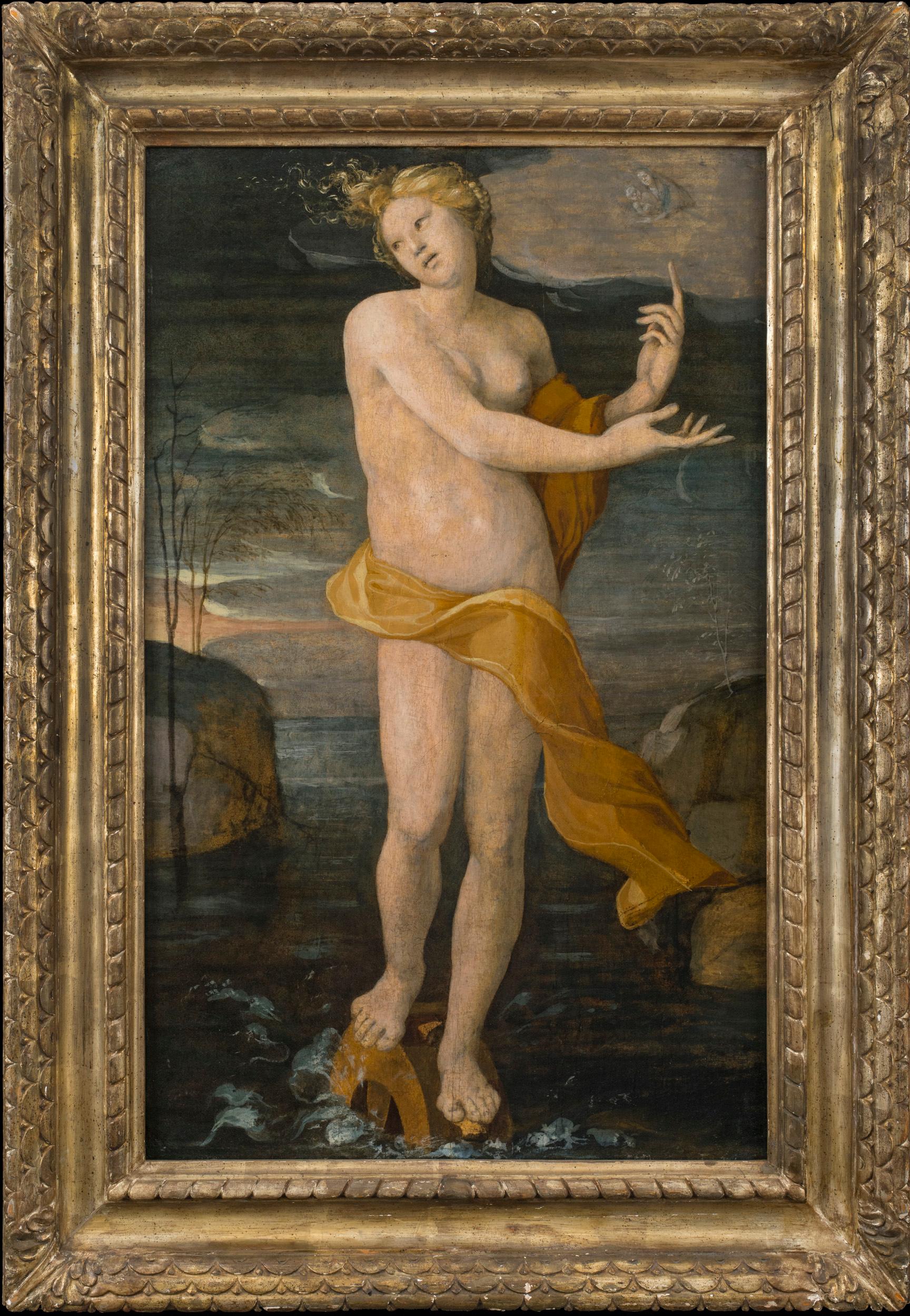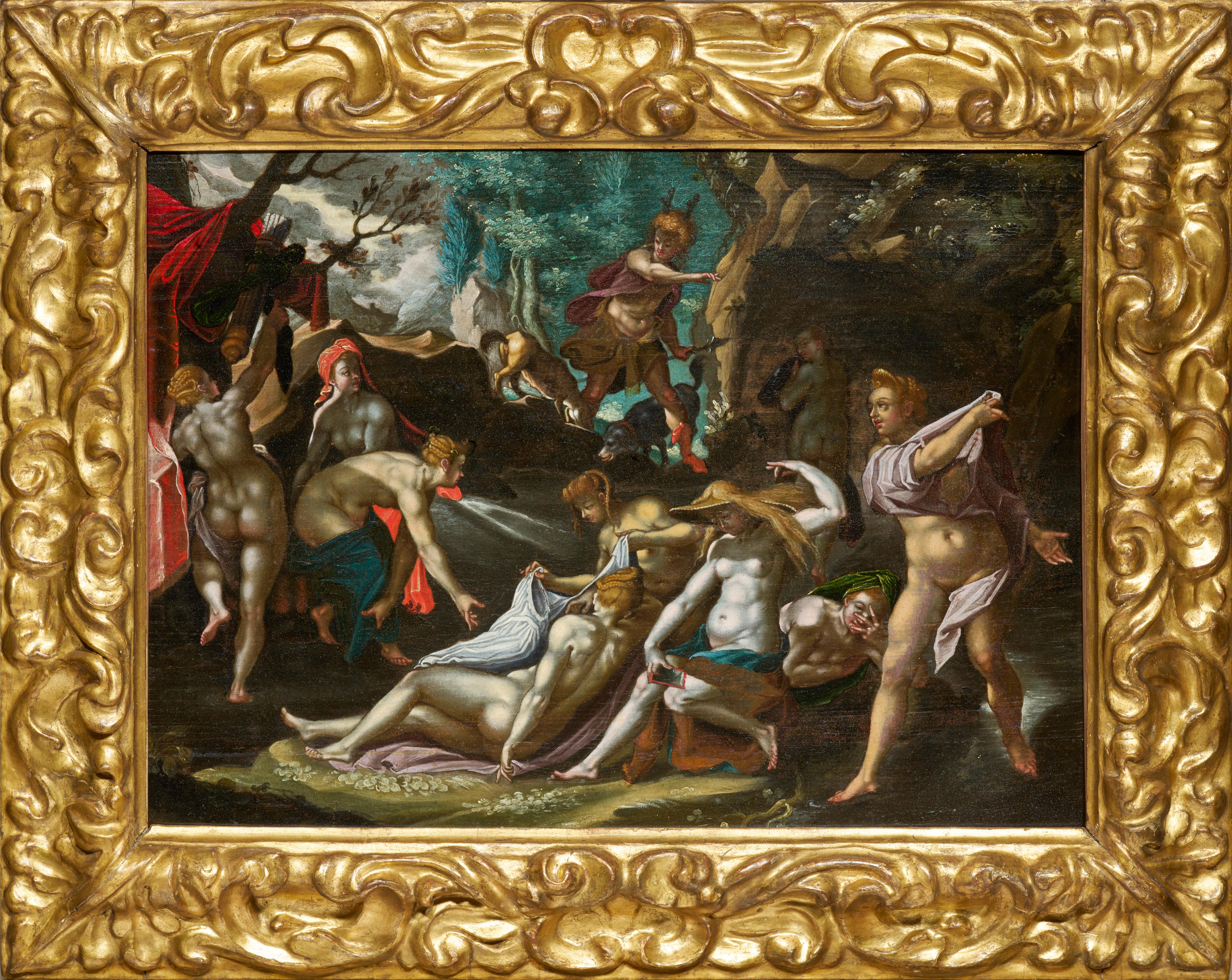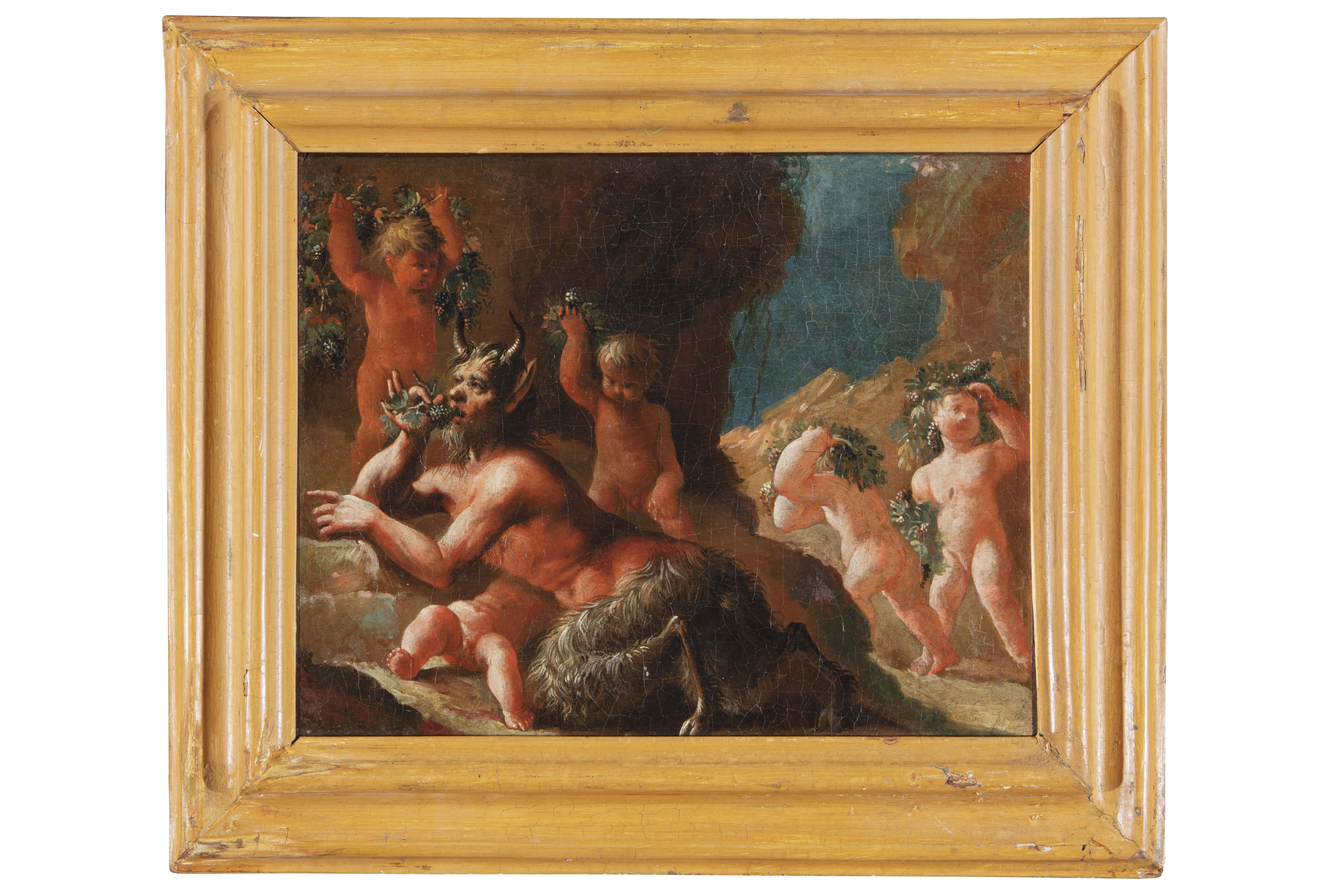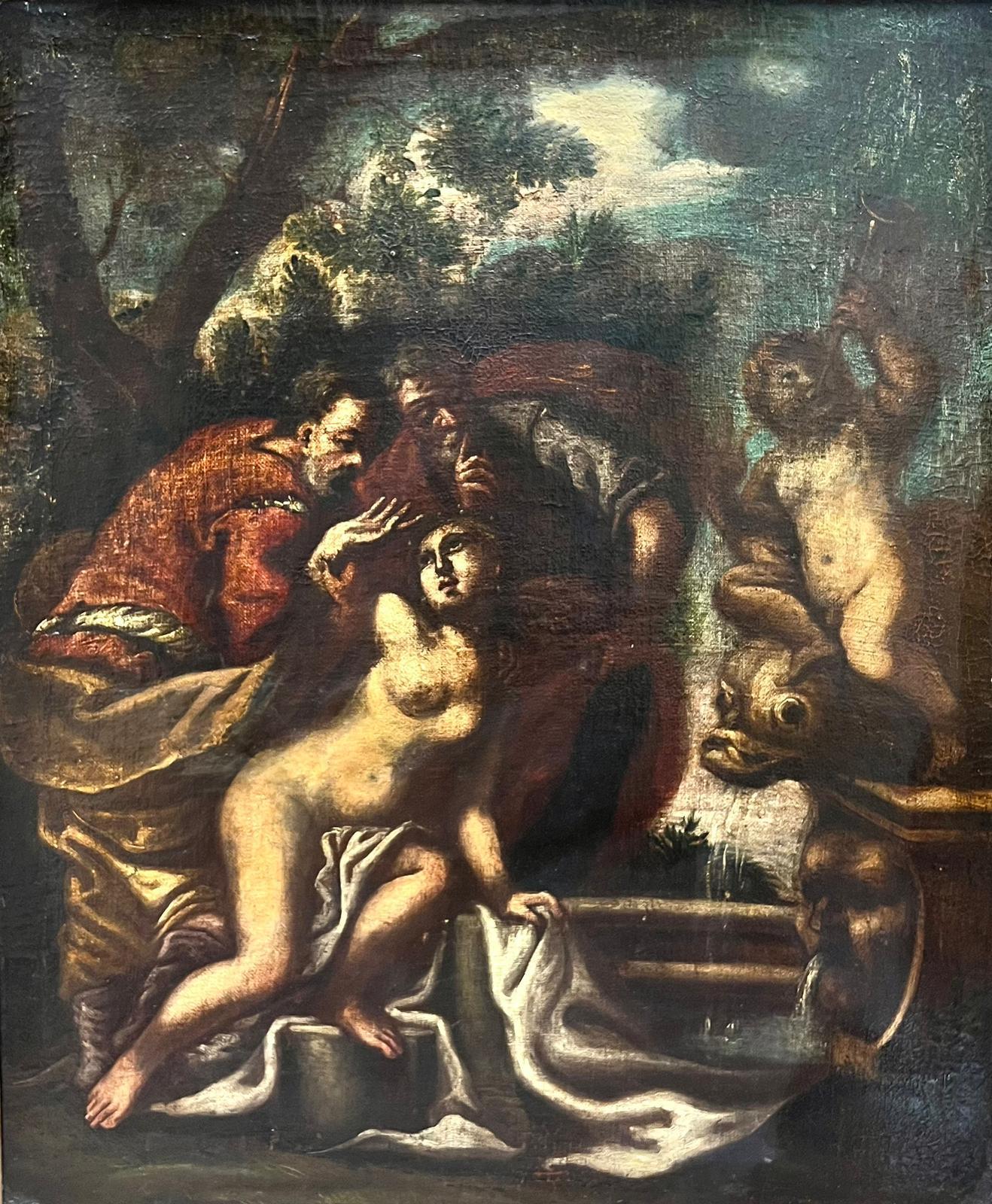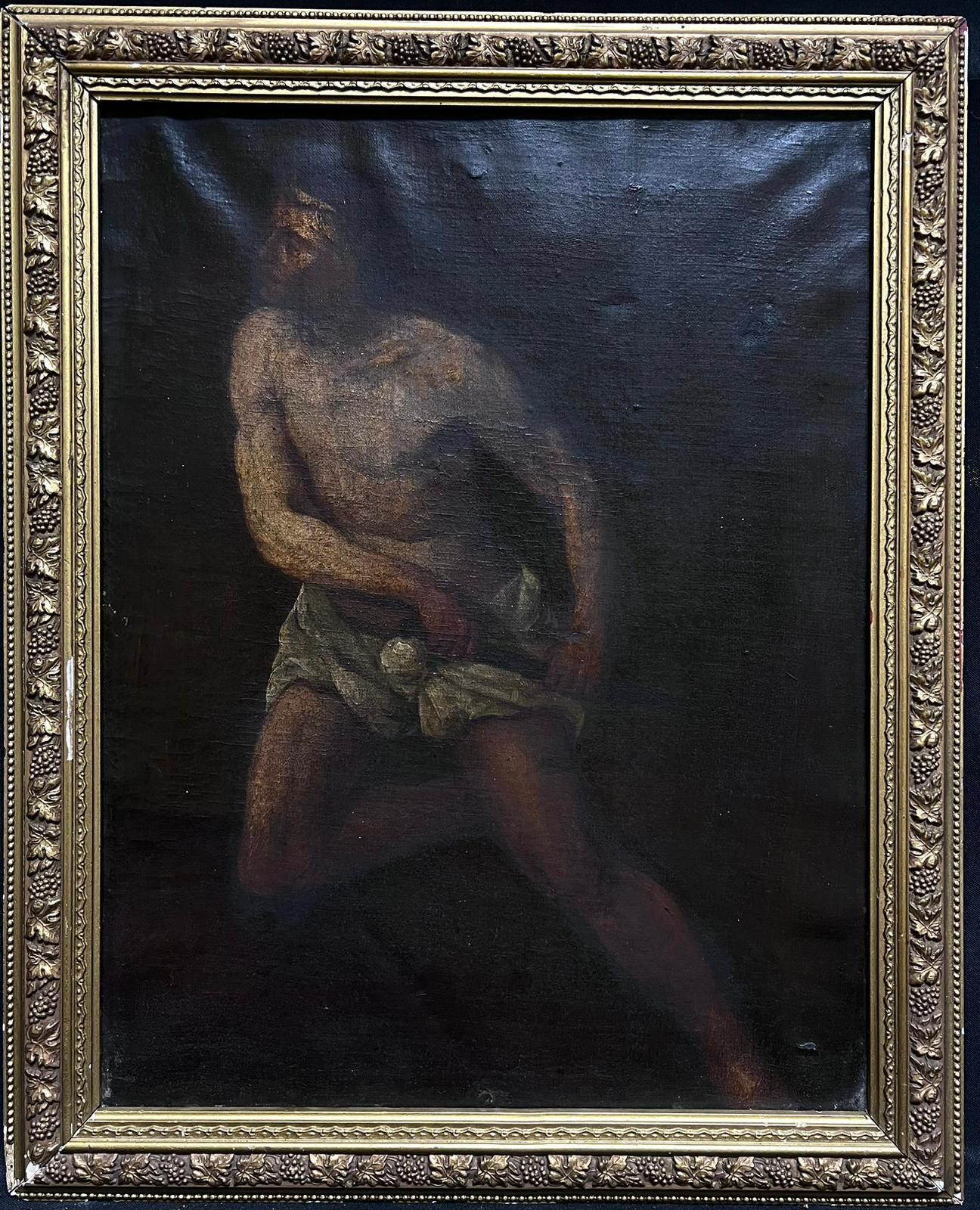Items Similar to Leda And The Swan By Workshop Of Bartholomaeus Spranger
Want more images or videos?
Request additional images or videos from the seller
1 of 10
Bartholomaeus SprangerLeda And The Swan By Workshop Of Bartholomaeus SprangerLate 16th century
Late 16th century
About the Item
Workshop of Bartholomaeus Spranger
16th Century Flemish
Leda and the Swan
Oil on panel
Retelling one of the most legendary Greco-Roman mythological tales, this exceptional oil on panel of Leda and the Swan is credited to the workshop of the great Flemish master Bartholomaeus Spranger. The story, in which Zeus transforms into a swan to seduce the young beauty Leda, has been taken up by artists since antiquity, and this painting represents a particularly sophisticated rendition of the myth. Leda is depicted as a languishing and voluptuous female nude, as Zeus, in the form of a swan, hovers over her figure in the background. Their children, Helen and Pollux, surround their mother, while a cherubic Cupid occupies the lower right corner of the scene. Lively and vibrant, the scene bears the very best characteristics of Spranger's workshop, exemplifying the elements that make his works so treasured.
Spranger was renowned for his painterly style that was revolutionary for its merger of northern European and Italian painterly techniques. Leda and the Swan reveals these same stylistic tendencies. The richness of color and the seductive expression of Leda, complete with her limpid yet direct gaze, recall the master artists of 16th-century Italy, such as Parmigianino and late Michelangelo. It particularly recalls Michelangelo's lost 1530s version of the same subject (a copy of which is in London's National Gallery), especially in the placement of the swan and Leda's draped posture.
The painting's attention to detail, however, reveals a link to Netherlandish traditions. A number of elements can be directly linked to other works by Spranger; the lavish, bejeweled gold arm cuff that Leda wears on her upper left arm, for instance, is strikingly similar to the cuff that appears on the nude nymph Scylla in Spranger's Glaucus and Scylla (Kunsthistorisches Museum, Vienna).
There are also parallels in the atmospheric effects conveyed in the background of each composition. In Glaucus and Scylla, storm clouds loom over the horizon, rendered with soft washes of colliding color. A similar effect is created in Leda, wherein the hint of the landscape beyond – appearing just over the swan to the right – is captured with delicate washes of color. Taken as a whole, the oil echoes all of the qualities characteristic of Spranger's later 16th-century work, a period during which he developed a larger circle of associates; it is among his workshop that this painting can thus be determined as originating.
As one of the most noted European painters working in the 16th century outside of Rome, Flemish master Bartholomaeus Spranger enjoyed incredible acclaim for his lively and vibrant painterly style. Though he was known to invoke subjects ranging from the religious to the mythological, it is for his mythological scenes that Spranger is most well-known today. This painting of Leda and the Swan, which bears the characteristics of Spranger's workshop, exemplifies the elements that make his works so treasured.
Late 16th century
Panel: 33 5/8" high x 46 7/8" wide
Frame: 41 5/8" high x 54 1/2" wide
- Creator:Bartholomaeus Spranger (Flemish)
- Creation Year:Late 16th century
- Dimensions:Height: 41.63 in (105.75 cm)Width: 54.5 in (138.43 cm)Depth: 1.63 in (4.15 cm)
- Medium:
- Movement & Style:
- Period:
- Condition:
- Gallery Location:New Orleans, LA
- Reference Number:
About the Seller
5.0
Vetted Seller
These experienced sellers undergo a comprehensive evaluation by our team of in-house experts.
Established in 1912
1stDibs seller since 2013
14 sales on 1stDibs
Typical response time: 3 hours
- ShippingRetrieving quote...Ships From: New Orleans, LA
- Return PolicyThis item cannot be returned.
More From This SellerView All
- Italian Panel with Satyr and NymphsLocated in New Orleans, LAThis extraordinary Italian gouache and oil on canvas brings two of the most popular characters from Greek mythology vividly the life - the nymph and the satyr. Both creatures are famed for their carefree natures and lascivious temperaments, and tales abound of satyrs pursing nubile nymphs in order to rape or seduce them, usually with little success. One such narrative humorously unfolds in the present piece, which depicts an indignant satyr captured by three nymphs with a golden net. The relationship between these two mythological creatures was a popular one for artists throughout the 18th and 19th centuries, though its origins stretch back to antiquity. Both satyrs and nymphs...Category
Early 19th Century Other Art Style Figurative Paintings
MaterialsCanvas, Oil, Gouache
- The Education of Achilles by Auguste-Clément ChrétienBy Auguste-Clément ChrétienLocated in New Orleans, LAThe Education of Achilles by the Centaur Chiron Signed and dated "A.C. Chrétien 1861" (lower right) Oil on canvas A masterpiece of French N...Category
19th Century Academic Nude Paintings
MaterialsOil
- Orientala By Reuven RubinBy Reuven RubinLocated in New Orleans, LAReuven Rubin Israeli | 1893-1974 Orientala Signed “Reuven Rubin" Oil on canvas A striking and unique work rendered in a breathtaking jewel-toned palette, Orientala by Rueven Rubin...Category
20th Century Post-Impressionist Nude Paintings
MaterialsOil, Canvas
- SalomeLocated in New Orleans, LAThis compelling portrait of Salome was composed by the French painter Marie Felix Hippolyte-Lucas. While the celebrated artist's oeuvre is filled with bright and cheerful portraits of aristocratic women surrounded by florals, here he takes a different approach. Hippolyte-Lucas' Salome is simultaneously exotic and highly modern, rendered in a style that is both theatrical and bold. The monumental work's rich color palette is filled with gem-inspired hues that lend drama to the scene, highlighting the blatant sexuality of this legendary seductress. Though Salome is not named in the New Testament, she has appeared time and time again in art and literature over the centuries, as both an innocent and a seductress. Her mother, Herodias, resented John the Baptist, who denounced her marriage to King Herod as unlawful. At one evening meal, Salome danced...Category
19th Century Other Art Style Nude Paintings
MaterialsCanvas, Oil
- MutineBy Guillaume SeignacLocated in New Orleans, LAGuillaume Seignac 1870-1924 | French Mutine Signed “G. Seignac” (lower right) Oil on canvas A mischievous maiden dominates this garden scene by French Academic artist Guillaume ...Category
Late 19th Century Academic Nude Paintings
MaterialsCanvas, Oil
- Baigneuses (Bathers)By Louis-Joseph CourtatLocated in New Orleans, LAFrench Academic painter Louis-Joseph Courtat displays his mastery of composition and the female form in this entrancing oil on canvas. Entitled Baigneuses, the work was painted for and exhibited at the 1885 Paris Salon, the foremost exhibition of painters in the Western world. Large in size, it captures two nude bathers within a tranquil beach scene. While the artist's skill for landscape painting is on display, it is his command of form, light and color that bring this canvas to life. The artist specialized in paintings that glorified the nude, and his skill is clear in the luminosity of his models' skin and the classical beauty of their form and proportions. With their soft, undulating curves and flowing hair, Courtat's models reflect the two key influences on the young painter, that of the great Jean-Auguste-Dominique Ingres as well as his teacher Alexandre Cabanel. Like these two greats who came before him, Courtat similarly follows in the artistic tradition of the female nude that is traceable to classical antiquity and the Italian Renaissance. Born in Paris in 1847, Courtat studied at the famed École des Beaux-Arts under Cabanel. He was one of the Academic master's first students at the school, where he began to teach in 1864. Displaying considerable skill at an early age, Courtat won the Prix de Rome around 1870, and subsequently studied in Rome for a number of years. He returned to Paris in 1873 to make his debut at the Salon, where he was met with immediate success, receiving a third class medal. He received medals again in 1874 and 1875, a remarkable achievement for a painter of his age. In addition to the monumental nudes...Category
19th Century Academic Nude Paintings
MaterialsCanvas, Oil
You May Also Like
- Allegory of FortuneLocated in New York, NYProvenance: S. Spinelli Collection, Florence; their sale, Galleria Pesaro, Milan, July 11-14, 1928, lot 112 (unsold); reoffered Galleria Luigi Bellini, Florence, April 23-26, 1934, lot 132, as manner of Baldassare Peruzzi Dr. Giacomo Ancona, Florence, 1930s, and after 1939, San Francisco; thence by descent to his son: Mario Ancona, San Francisco; thence by descent to his children: Mario Ancona III and Victoria Ancona, San Francisco, until 1995; thence to: Phyllis Ancona Green, widow of Mario Ancona, Los Angeles (1995-2012) Literature: Donato Sanminiatelli, Domenico Beccafumi. Milan 1967, p. 170 (under paintings attributed to Beccafumi) Among the precious survivors of Renaissance secular paintings for domestic interiors are several unusual and particularly attractive panels painted in Siena at the end of the fifteenth and beginning of the sixteenth centuries. These paintings depict exemplary figures from antiquity—heroes or heroines, as well as allegorical, literary, and mythological figures. For the most part, these panels have survived in groups of three, although it is possible that some of these works were painted either as part of larger series or as individual projects. One such trio by Beccafumi consists of two paintings now at the National Gallery, London (Marcia and Tanaquil) and a third in the Galleria Doria-Pamphilj, Rome (Cornelia). These were commissioned around 1517–1519 for the bedroom of Francesco di Camillo Petrucci in Siena and were most likely placed together as elements in the wall decoration (spalliere) or installed above the back of a bench or cassapanca. Another, earlier (ca. 1495–1500), set of three—Guidoccio Cozzarelli’s Hippo, Camilla, and Lucretia (Private Collection, Siena) survives with its original wooden framework—a kind of secular triptych. Judith, Sophonisba, and Cleopatra in the collection of the Monte dei Paschi, Siena, are by an anonymous artist close to Beccafumi called the “Master of the Chigi-Saracini Heroines.” Girolamo di Benvenuto’s Cleopatra, Tuccia, and Portia are dispersed (homeless, Prague, Chambery), and Brescianino’s Faith, Hope, and Charity are in the Pinacoteca Nazionale in Siena. The present painting first appeared in the Spinelli sale in Florence in 1934, at which time it was sold with two panels of identical size and format. Each was catalogued as being by the “manner of Baldassare Peruzzi” and of unidentified subject. Of these, the painting depicting a male figure turned to the right has recently reappeared in a private Italian collection, while the location of the third work, portraying a cloaked figure turned three-quarters left, remains unknown. Our panel depicts the allegorical figure of Fortune. Here she is represented in typical fashion as a nude female figure balanced on a wheel (sometimes called the Rota Fortunae), her billowing drapery indicating that she is as changeable as the wind. The appearance of the Virgin and Child in the cloud at the upper right is an unusual addition to the iconography. The subjects of the two pendant male...Category
16th Century Old Masters Paintings
MaterialsOil, Panel
- Diana and Actaeon, a Mannerist painting after Joseph Heintz the ElderLocated in PARIS, FRThis painting seduced us with its rich colors. Depicting Diana and her companions surprised by Actaeon, it was inspired by an engraving by Aegidius Sadeler II after a painting by Jos...Category
17th Century Old Masters Nude Paintings
MaterialsOil, Wood Panel
- 18th century By French maestro Bacchanal Oil on canvasLocated in Milano, LombardiaDuring a festive bacchanal a big satyr is eating grapes, lying on the ground and surrounded by a large group of putti who, with festoons and vine leaves, fill and populate the pictor...Category
18th Century Old Masters Figurative Paintings
MaterialsCanvas, Oil
- Large 1700 Italian Old Master Nude Bather with Classical Figures Water FountainLocated in Cirencester, GloucestershireItalian School, circa 1700's Classical figures in landscape oil on canvas, framed framed: 36 x 32 inches canvas: 30 x 25 inches provenance: private collection, UK condition: very goo...Category
Early 18th Century Old Masters Figurative Paintings
MaterialsOil, Canvas
- Early 17th Century Italian Old Master Semi Nude Man with Dagger oil paintingBy Michelangelo Merisi da CaravaggioLocated in Cirencester, GloucestershireSemi Nude Man drawing a Dagger Italian School, early 17th century circle of Caravaggio oil on canvas, framed framed: 21 x 17 inches canvas : 18 x 14 i...Category
Early 17th Century Old Masters Portrait Paintings
MaterialsOil, Canvas
- Portrait of Putti Playing - French 17th century art Old Master oil paintingLocated in London, GBThis stunning French 17th century Old Master oil painting is by Baroque artist Laurent de la Hyre. It was painted circa 1645 and has excellent provenance from Christie's. The painti...Category
17th Century Old Masters Portrait Paintings
MaterialsOil
